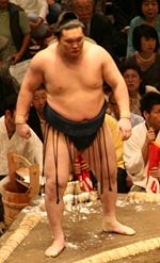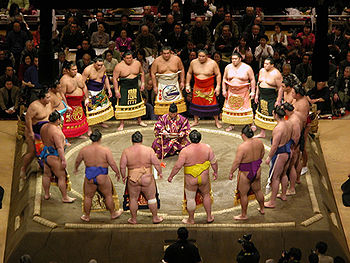
Mawashi
Encyclopedia
In sumo
, a mawashi is the belt that the rikishi (or sumo wrestler) wears during training or in competition. Upper ranked professional wrestlers wear a keshō-mawashi (see below) as part of the ring entry ceremony or dohyo-iri.
 For top- (sekitori
For top- (sekitori
-) ranked professional rikishi, it is made of silk
and comes in a variety of colors. It is approximately 30 feet (9.1 m) in length when unwrapped, about two feet wide and weighs between eight and eleven pounds. It is wrapped several times around the rikishi and fastened in the back by a large knot. A series of matching colour, stiffened silk fronds, called sagari are inserted into the front of the mawashi. Their number varies from 13 to 25, and is always an odd number. If these fall out during competition the gyoji
(or referee) will throw them from the ring at the first opportunity.
Sometimes a rikishi may wear his mawashi in such a way as to give him some advantage over his opponent. He may wear it loosely to make it more difficult to be thrown or he may wrap it tightly and splash a little water on it to help prevent his opponent from getting a good grip on it. His choice will depend on the type of techniques he prefers to employ in his bouts. Thus a wrestler preferring belt sumo will usually wear it more loosely, while those preferring pushing techniques will tend to wear the mawashi more tightly.
Many rikishi are superstitious and they will change the color of their mawashi to change their luck. Sometimes a poor performance will cause them to change colors for the next tournament, or even during a tournament, in an attempt to change their luck for the better.
The rikishi only wear the silk mawashi during competitive bouts either during ranking tournaments or touring displays. During training a heavy cotton
mawashi is worn. For senior rikishi in the top two divisions (the so-called sekitori
) this belt is coloured white, and it is worn with one end distinctively looped at the front. Sagari are not worn during training.
Rikishi ranked in the lower divisions wear a black cotton mawashi both for training in and in competition. In competition cotton sagari are inserted into the belt, but these are not stiffened.
Amateur sumo wrestlers are expected to wear a white cotton mawashi, without the looping accorded to the senior professional's training garb.
If a wrestler's mawashi comes off during a tournament bout, he is automatically disqualified. This is extremely rare, but did occur in May 2000 when sandanme wrestler Asanokiri was embarrassed during a match with Chiyohakuho.
 Sekitori
Sekitori
also wear a second ceremonial keshō-mawashi during their ring entering ceremony. The silk 'belt' opens out at one end into a large apron which is usually heavily embroidered and with thick tassles at the bottom. The keshō-mawashi may advertise the produce of a sponsor of the rikishi (For example Bulgarian Ozeki Kotooshu is sponsored by a Japanese brand of yogurt, "Bulgaria", which is prominently displayed on the front of his keshō-mawashi) or be a gift from one of the rikishi's support groups. Popular rikishi may be given many of these keshō-mawashi.
 Yokozuna have matching sets of three keshō-mawashi, with two being worn by his wrestler assistants (his tachimochi
Yokozuna have matching sets of three keshō-mawashi, with two being worn by his wrestler assistants (his tachimochi
and tsuyuharai
) during his ring entrance ceremony.
In the Edo period
the keshō-mawashi also served as the wrestler's fighting mawashi. However, as the aprons become more ornate, eventually the two functions were split apart. In this period wrestlers were normally sponsored by feudal daimyō
or overlords, whose clan crest would therefore appear on the keshō-mawashi.
Sumo
is a competitive full-contact sport where a wrestler attempts to force another wrestler out of a circular ring or to touch the ground with anything other than the soles of the feet. The sport originated in Japan, the only country where it is practiced professionally...
, a mawashi is the belt that the rikishi (or sumo wrestler) wears during training or in competition. Upper ranked professional wrestlers wear a keshō-mawashi (see below) as part of the ring entry ceremony or dohyo-iri.
Mawashi

Sekitori
A sekitori is a sumo wrestler who is ranked in one of the top two professional divisions: makuuchi and juryo.Currently there are 70 rikishi in these divisions...
-) ranked professional rikishi, it is made of silk
Silk
Silk is a natural protein fiber, some forms of which can be woven into textiles. The best-known type of silk is obtained from the cocoons of the larvae of the mulberry silkworm Bombyx mori reared in captivity...
and comes in a variety of colors. It is approximately 30 feet (9.1 m) in length when unwrapped, about two feet wide and weighs between eight and eleven pounds. It is wrapped several times around the rikishi and fastened in the back by a large knot. A series of matching colour, stiffened silk fronds, called sagari are inserted into the front of the mawashi. Their number varies from 13 to 25, and is always an odd number. If these fall out during competition the gyoji
Gyoji
A Gyōji is a referee in professional sumo wrestling in Japan.Gyōji usually enter the sumo world as teenagers and remain employees of the Sumo Association until they retire aged 65.-Responsibilities:...
(or referee) will throw them from the ring at the first opportunity.
Sometimes a rikishi may wear his mawashi in such a way as to give him some advantage over his opponent. He may wear it loosely to make it more difficult to be thrown or he may wrap it tightly and splash a little water on it to help prevent his opponent from getting a good grip on it. His choice will depend on the type of techniques he prefers to employ in his bouts. Thus a wrestler preferring belt sumo will usually wear it more loosely, while those preferring pushing techniques will tend to wear the mawashi more tightly.
Many rikishi are superstitious and they will change the color of their mawashi to change their luck. Sometimes a poor performance will cause them to change colors for the next tournament, or even during a tournament, in an attempt to change their luck for the better.
The rikishi only wear the silk mawashi during competitive bouts either during ranking tournaments or touring displays. During training a heavy cotton
Cotton
Cotton is a soft, fluffy staple fiber that grows in a boll, or protective capsule, around the seeds of cotton plants of the genus Gossypium. The fiber is almost pure cellulose. The botanical purpose of cotton fiber is to aid in seed dispersal....
mawashi is worn. For senior rikishi in the top two divisions (the so-called sekitori
Sekitori
A sekitori is a sumo wrestler who is ranked in one of the top two professional divisions: makuuchi and juryo.Currently there are 70 rikishi in these divisions...
) this belt is coloured white, and it is worn with one end distinctively looped at the front. Sagari are not worn during training.
Rikishi ranked in the lower divisions wear a black cotton mawashi both for training in and in competition. In competition cotton sagari are inserted into the belt, but these are not stiffened.
Amateur sumo wrestlers are expected to wear a white cotton mawashi, without the looping accorded to the senior professional's training garb.
If a wrestler's mawashi comes off during a tournament bout, he is automatically disqualified. This is extremely rare, but did occur in May 2000 when sandanme wrestler Asanokiri was embarrassed during a match with Chiyohakuho.
Keshō-mawashi

Sekitori
A sekitori is a sumo wrestler who is ranked in one of the top two professional divisions: makuuchi and juryo.Currently there are 70 rikishi in these divisions...
also wear a second ceremonial keshō-mawashi during their ring entering ceremony. The silk 'belt' opens out at one end into a large apron which is usually heavily embroidered and with thick tassles at the bottom. The keshō-mawashi may advertise the produce of a sponsor of the rikishi (For example Bulgarian Ozeki Kotooshu is sponsored by a Japanese brand of yogurt, "Bulgaria", which is prominently displayed on the front of his keshō-mawashi) or be a gift from one of the rikishi's support groups. Popular rikishi may be given many of these keshō-mawashi.

Tachimochi
In professional sumo, the tachimochi is one of the two attendants that accompany a yokozuna when he performs his dohyo-iri or ring entrance ceremony. The other attendant is called the tsuyuharai....
and tsuyuharai
Tsuyuharai
In professional sumo, the tsuyuharai is one of the two attendants that accompany a yokozuna when he performs his dohyo-iri or ring entrance ceremony. The other attendant is called the tachimochi....
) during his ring entrance ceremony.
In the Edo period
Edo period
The , or , is a division of Japanese history which was ruled by the shoguns of the Tokugawa family, running from 1603 to 1868. The political entity of this period was the Tokugawa shogunate....
the keshō-mawashi also served as the wrestler's fighting mawashi. However, as the aprons become more ornate, eventually the two functions were split apart. In this period wrestlers were normally sponsored by feudal daimyō
Daimyo
is a generic term referring to the powerful territorial lords in pre-modern Japan who ruled most of the country from their vast, hereditary land holdings...
or overlords, whose clan crest would therefore appear on the keshō-mawashi.

